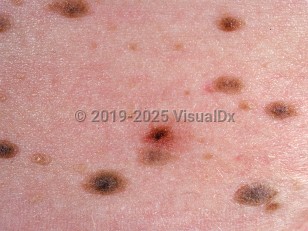Familial atypical multiple mole-melanoma syndrome in Adult
Alerts and Notices
Important News & Links
Synopsis

Familial atypical multiple mole-melanoma (FAMMM) syndrome is an autosomal dominantly inherited melanoma predisposition syndrome in which germline CDKN2A mutations (and much less commonly CDK4 mutations) lead to a predisposition to melanoma and atypical moles, as well as pancreatic cancer in some kindreds. Nomenclature has evolved, with this entity formerly or also known as B-K mole syndrome, familial atypical multiple mole melanoma-pancreatic carcinoma (FAMM-PC) syndrome, familial Clark nevus syndrome, familial atypical mole syndrome, familial dysplastic nevus syndrome, melanoma-pancreatic cancer syndrome, and familial atypical mole melanoma (FAMM) syndrome.
Features associated with FAMMM syndrome include multiple cases of melanoma within a family, young age at diagnosis of melanoma, family members with pancreatic cancer, and family members with multiple primary melanomas.
The CDKN2A gene encodes two proteins, p16 and p14ARF, but mutations seen in melanoma families are associated more often with an impaired activity of p16. Not all mutation carriers will develop melanoma. Risk differences have been seen from one geographic area of residence to another, suggesting that sun exposure, or other co-inherited factors, also contribute to the incidence of the disease.
Melanoma in a patient with mutated CDKN2A occurs at a significantly earlier age (median 40 versus 50 years), and multiple primary melanomas are more common in individual patients (40% versus 15% in one study) compared with families harboring wild-type CDKN2A. The risk of pancreatic cancer is estimated to be 13-22 times higher for FAMMM syndrome patients than the general population. This risk increases to 38-fold in CDKN2A-mutant FAMMM syndrome patients. Nevi in patients with FAMMM syndrome are phenotypically diverse.
Melanoma-astrocytoma syndrome is a rare syndrome thought to be a variant of FAMMM syndrome secondary to loss of p14ARF function.
Related topic: amelanotic melanoma
Features associated with FAMMM syndrome include multiple cases of melanoma within a family, young age at diagnosis of melanoma, family members with pancreatic cancer, and family members with multiple primary melanomas.
The CDKN2A gene encodes two proteins, p16 and p14ARF, but mutations seen in melanoma families are associated more often with an impaired activity of p16. Not all mutation carriers will develop melanoma. Risk differences have been seen from one geographic area of residence to another, suggesting that sun exposure, or other co-inherited factors, also contribute to the incidence of the disease.
Melanoma in a patient with mutated CDKN2A occurs at a significantly earlier age (median 40 versus 50 years), and multiple primary melanomas are more common in individual patients (40% versus 15% in one study) compared with families harboring wild-type CDKN2A. The risk of pancreatic cancer is estimated to be 13-22 times higher for FAMMM syndrome patients than the general population. This risk increases to 38-fold in CDKN2A-mutant FAMMM syndrome patients. Nevi in patients with FAMMM syndrome are phenotypically diverse.
Melanoma-astrocytoma syndrome is a rare syndrome thought to be a variant of FAMMM syndrome secondary to loss of p14ARF function.
Related topic: amelanotic melanoma
Codes
ICD10CM:
D23.9 – Other benign neoplasm of skin, unspecified
SNOMEDCT:
254819008 – Atypical mole syndrome
D23.9 – Other benign neoplasm of skin, unspecified
SNOMEDCT:
254819008 – Atypical mole syndrome
Look For
Subscription Required
Diagnostic Pearls
Subscription Required
Differential Diagnosis & Pitfalls

To perform a comparison, select diagnoses from the classic differential
Subscription Required
Best Tests
Subscription Required
Management Pearls
Subscription Required
Therapy
Subscription Required
References
Subscription Required
Last Reviewed:08/15/2021
Last Updated:01/16/2022
Last Updated:01/16/2022
 Patient Information for Familial atypical multiple mole-melanoma syndrome in Adult
Patient Information for Familial atypical multiple mole-melanoma syndrome in Adult
Premium Feature
VisualDx Patient Handouts
Available in the Elite package
- Improve treatment compliance
- Reduce after-hours questions
- Increase patient engagement and satisfaction
- Written in clear, easy-to-understand language. No confusing jargon.
- Available in English and Spanish
- Print out or email directly to your patient
Upgrade Today

Familial atypical multiple mole-melanoma syndrome in Adult

